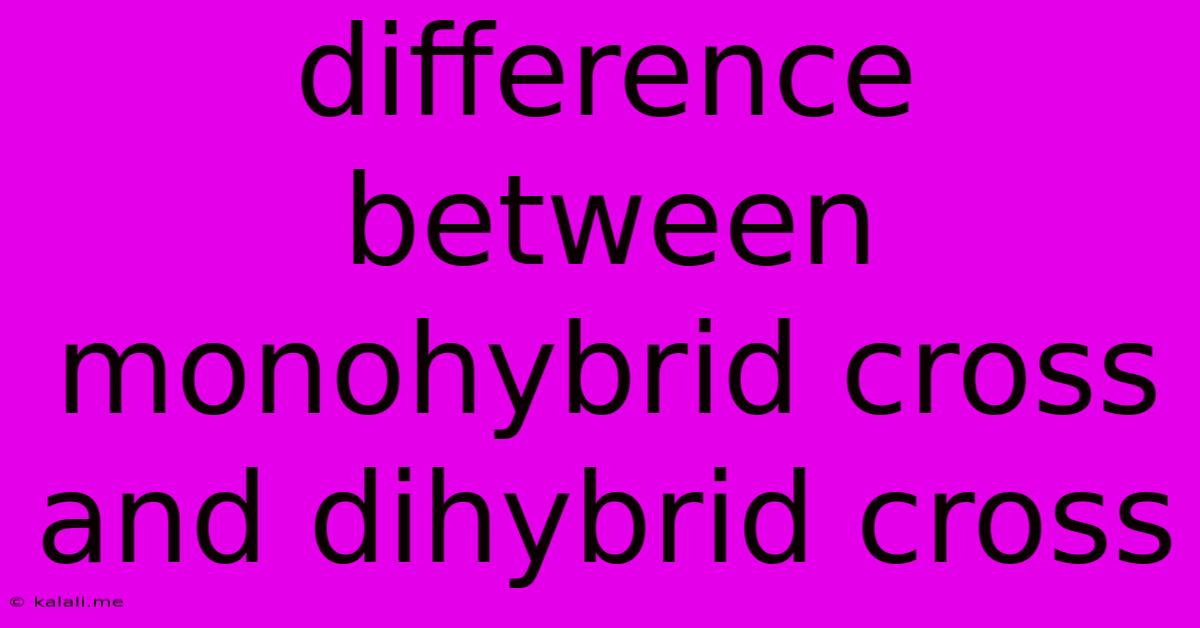Difference Between Monohybrid Cross And Dihybrid Cross
Kalali
Jun 14, 2025 · 3 min read

Table of Contents
Understanding the Difference Between Monohybrid and Dihybrid Crosses
This article explores the fundamental differences between monohybrid and dihybrid crosses, two crucial concepts in Mendelian genetics. Understanding these distinctions is key to grasping inheritance patterns and predicting the probabilities of offspring genotypes and phenotypes. We'll delve into the definitions, methodologies, and implications of each cross, clarifying the core differences through examples.
What is a Monohybrid Cross?
A monohybrid cross focuses on the inheritance of a single trait controlled by a single gene. This simple cross allows for a clear understanding of dominant and recessive alleles and their expression in offspring. The classic example is Gregor Mendel's experiment with pea plant flower color, where one parent plant had purple flowers (dominant allele, denoted as 'P') and the other had white flowers (recessive allele, denoted as 'p').
- Key Features:
- Involves one gene with two alleles.
- Tracks the inheritance of a single trait.
- Results in a predictable phenotypic ratio (e.g., 3:1 for a simple dominant-recessive relationship).
- Useful for understanding basic Mendelian inheritance patterns.
What is a Dihybrid Cross?
A dihybrid cross, on the other hand, tracks the inheritance of two different traits simultaneously. Each trait is controlled by a separate gene, located on different chromosomes. This cross provides insights into how different genes are inherited independently, leading to a greater diversity of offspring genotypes and phenotypes. For example, considering pea plant color (purple, P, or white, p) and seed shape (round, R, or wrinkled, r) in a single cross.
- Key Features:
- Involves two genes, each with two alleles.
- Tracks the inheritance of two different traits.
- Illustrates the principle of independent assortment (Mendel's Second Law).
- Results in a more complex phenotypic ratio (e.g., 9:3:3:1 for a simple dominant-recessive relationship with two genes).
- Useful for understanding more complex inheritance patterns and gene interactions.
Comparing Monohybrid and Dihybrid Crosses: A Table Summary
| Feature | Monohybrid Cross | Dihybrid Cross |
|---|---|---|
| Number of Genes | One | Two |
| Number of Traits | One | Two |
| Allele Combinations | Fewer (e.g., PP, Pp, pp) | More (e.g., PPRR, PPRr, PPrr, PpRR, PpRr, Pprr, ppRR, ppRr, pprr) |
| Punnett Square Size | 3x3 or 2x2 (depending on parental genotypes) | 4x4 or 16 square Punnett Square |
| Phenotypic Ratio (simple dominant-recessive) | 3:1 | 9:3:3:1 |
| Principle Illustrated | Basic Mendelian inheritance, dominance/recessiveness | Independent assortment, Mendelian inheritance |
| Complexity | Simpler to analyze | More complex to analyze |
Practical Applications and Significance
Both monohybrid and dihybrid crosses are essential tools in genetics. Monohybrid crosses form the foundation of understanding basic inheritance patterns, while dihybrid crosses provide a more nuanced view of how multiple genes interact during inheritance. These principles have applications in various fields, including:
- Agriculture: Predicting the traits of offspring in crop breeding programs.
- Medicine: Understanding the inheritance of genetic diseases.
- Evolutionary Biology: Analyzing the genetic changes that occur in populations over time.
- Animal Breeding: Improving desirable characteristics in livestock.
In conclusion, while both monohybrid and dihybrid crosses are fundamental to understanding genetics, they differ significantly in their scope and complexity. Monohybrid crosses offer a simplified model for studying single gene inheritance, whereas dihybrid crosses reveal the intricacies of multi-gene inheritance and the principle of independent assortment. Mastering both concepts is crucial for a comprehensive understanding of heredity.
Latest Posts
Latest Posts
-
Cuanto Es 98 7 Fahrenheit En Centigrados
Jun 14, 2025
-
Which Of The Following Statements About Rfid Is Not True
Jun 14, 2025
-
Is Sulphur Dioxide A Greenhouse Gas
Jun 14, 2025
-
Average Gpa For University Of Toronto
Jun 14, 2025
-
How Many Chambers Are In The Fish Heart
Jun 14, 2025
Related Post
Thank you for visiting our website which covers about Difference Between Monohybrid Cross And Dihybrid Cross . We hope the information provided has been useful to you. Feel free to contact us if you have any questions or need further assistance. See you next time and don't miss to bookmark.